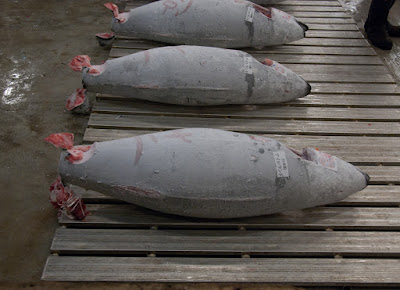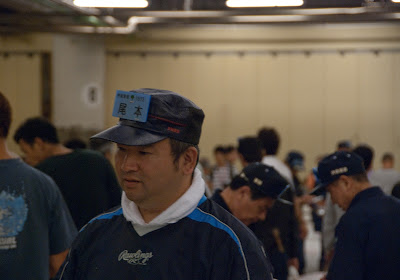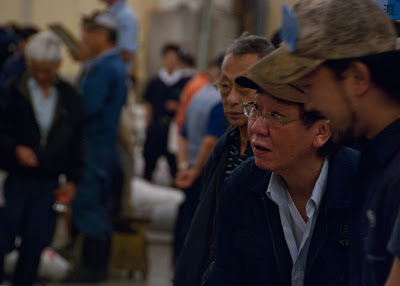One of the famous highlights of Tokyo is the fish-market, where every day the catch of many ships is brought in and from here distributes to the whole Tokyo metro (and maybe beyond). During my last visit to Japan I went to see the Market and was very impressed. And so I was enthusiastic to revisit. The height of the visit is to see the auction of tuna that is freshly loaded from fishing boats.
One problem. The action at the market is early in the day (at 4-5am), and it also involves seeing many fish and sea creatures. Both of these aspects deterred my family. And so, I set out alone. I woke at 4am, and walked from our hotel to the market (about 15 minutes).
It was dark outside, and the market entry was full of tracks and small motor-driven vehicles for carrying loads. It was a bit scary to negotiate this constant traffic.
I aimed for the area where the Tuna auctions take place. At some point I found a bunch of tourists standing close to a big door, where we could see large tuna being arranged on the floor. The door however was being closed, and we could not see anything. We stood there waiting for it to re-open. After few minutes a policeman came by and told us we need to go register at a visitor center.
It took a while to find this center, as it was on the other end of the market. There we found a queue and stood in line with many other tourists.
It turned out that due to the large number of visitors, only a set number is allowed to see the auctions. We stood in queue for about 15-20 minute without much progress, although the queue beyond us got longer and longer. At some point we started to move forward, and were ushered into a large hall where each of us got a green vest to wear. We stood in nice lines and had a short movie about the market.
After waiting for more than 1/2 an hour, we were lead from the waiting hall toward the tuna auction area. By now there was light outside, and we formed a green snake along the route.
We passed few warehouses, and one had a door somewhat open and we could see rows and rows of frozen tuna fish.
We were led through a door into one of the halls, and there we stood between two ropes and watched what took place in the hall.
Here there were large tunas arranged on wooden frames. Each had its tail cut off, and part of its skin exposed near the tail.
The prospective shoppers moved around the tunas and inspected them. This involved lighting a flash light on the exposed flap of skin and examining carefully.
Then the inspector would take a small hatchet (they all had one) and by series of blows to the exposed tail meet, break few slivers of meat and inspect them.
In few cases they also flipped over the tuna to look at its underside.
Some of the buyers were in groups, one with the sign on his hat showing that he was an official buyer, and others without, and having discussions of specific fish.
This went on for a while and at some point I was afraid that there it would stop.
However, then the action started. One auctioneer came out and stood on a small stool. He had a different type of hat and a bell. He started tolling the bell. About the same time two others started doing the same act in other parts of the hall.
Then the bell rings picked up the pace and the auction started. The auctioneer seemed to talk without stop. The first one (who was a bit further from us) was moving his whole body and waving his arms as we was going through the auctions.
The buyers did all kind of hand moves to indicate their bids, but did not talk or shout. In most cases these were very sutble signs.
It was easier to watch the closer auction, where the auctioneer was also animated, although not to that extent. I know when a fish was sold, because a special person how was closely following the action would move in with a brash and mark the fish.
Once the fish marked, people (I assume workers from the buyer's company) would come in and remove the fish onto hand trolleys.
When the first row of tuna was sold, the wooden frames were removed and the auctioneer moved the stool forward and continued.
In the meantime similar action was taking place down the hall on the next set of tunas.
Then there was short pause, and a new auctioneer took over for the next rows of tunas. I am not sure if this was because they were represented by another seller, or this was division of work between the auctioneers (they seemed to have the same uniform). Again, the bell tolling act took place, and then action started again.
This went on for while until all the fish were sold (or maybe some were left without a buyer).
After half an hour we were told that our time was out, and were asked to leave our vests on the way out. Outside the hall there was one area that contained saw that cut whole fish. Different trolleys waited by, and then left with the tuna cut in to halfs or quarters.
I started walking in the area outside the halls. Here there was a lot of traffic of motor-driven trolleys and hand carried ones.
The motor ones looked like a barrel carrying a small bed. The drivers were very experienced and moved easily with bare space on either side without slowing down much.
In the middle of this whole activity two landmarks were noticeable. The first was a large pile of styrofoam packing.
The other was a shrine that was located within the market area.
Just next to the whole-sale market was a small market open to the public. Here there were shops and restaurants. Some of these were apparently recommended by travel books, as they had long lines of tourists waiting next to them. Others were quite empty.
I decided to go for a restaurant that served local market workers. It was full and I had to wait a bit to get a chair. The waitress beyond the bar told me "no english menu", but I managed to order a Ramen-soup for breakfast. It was interesting to watch the interactions among the clients and the stuff (one waitress and three cooks working furiously in a small kitchen).
Then I decided to venture into the intermediate-wholesale area (where smaller distributors sold to shop owners). I first found myself in the vegetable market. Here it turned out that auctions were also taking place over crops of radishes and beans.
From there I arrived to the fish stalls. Here various fish and sea food were sold.
In some of the shops I encountered the tuna that was sold before. Some of it was cut while still frozen into slabs.
In other places the tuna was left to thaw and then cut carefully in a very artful way to separate the edible choice steaks from the bones and other tissues.
Overall it was an interesting visit. It was raining when I left the market, and although I felt like it was midday, it was only 730am. I was a bit disappointed about the contrast to my visit almost 10 years ago (April 2000), when the whole market was simply accessible to tourists. I guess that is the price of fame.
























































No comments:
Post a Comment